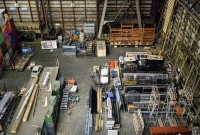- Home
- Business Processes
- Industry Knowledge
- Aerospace Industry
- Automotive Industry
- Banking Domain
- BFSI Industry
- Consumer/ FMCG Industry
- Chemicals Industry
- Engineering & Construction
- Energy Industry
- Education Domain
- Finance Domain
- Hospitality Domain
- Healthcare Industry
- Insurance Domain
- Retail Industry
- Travel and Tourism Domain
- Telecom Industry
- Leadership Skills
- eLearning
- Home
- Business Processes
- Warehouse Management
- Different Types of Warehouses
Different Types of Warehouses
Warehouses may seem like a simple, straightforward concept, but they actually include a variety of different types of warehouses that all have their own niche. The type of warehousing that’s right for you depends on your specific industry, location, and needs. From private warehousing, distribution centers, and climate-controlled warehouses, there’s an option to suit every business.
Warehouses may seem like a simple, straightforward concept, but they actually include a variety of different types of warehouses that all have their own niche. The type of warehousing that’s right for you depends on your specific industry, location, and needs. From private warehousing, distribution centers, and climate-controlled warehouses, there’s an option to suit every business.
Distribution Center
Distribution centers are warehouses where goods are stored temporarily. In these warehouses products are received from suppliers, sorted and packed and then rapidly shipped out to customers. An example of a distribution center is a warehouse that handles perishable products. They will receive shipments in the morning and distribute them by the end of the same day.
Private Warehouse
These warehouses are privately owned and generally used by retail corporations or engineering companies to store their inventory.
Public Warehouse
Public warehouses can be leased to companies with short-term distribution needs. For example, retailers with their own private warehouse may seek out additional storage space at a public warehouse just to keep surplus of inventory for a short while. Once spaces free up in their own warehouse, they’ll discontinue the use of the public space. Private warehouses will have higher fixed costs but lower unit operating costs, whereas the public warehouses will potentially cost you higher in terms of variable costs.
Automated Warehouse
Automated warehouses are, nearly completed automated. With very little manpower required for supervision, these warehouses operate using the latest software technology, cranes, and carriers to maintain and carry out their duties.
Climate-Controlled Warehouse
Warehouses store many different products, often including those that need to be kept at a specific temperature. Items that require special handling conditions should be kept in a climate-controlled warehouse. This can range from freezing temperatures to keep frozen products in tact to humidity-controlled environments for delicate botanical products and even dirt-free facilities to keep sensitive computer equipment safe. Moreover, they are control environments to ensure desired quality and usability with humidity, microorganism prevention mechanisms.
Retail Warehouse
Retail warehouses are stores dealing in consumer goods that are operated in single-level buildings. Generally, they are limited to 1000 square meter retail spaces. The floor space is mostly majorly allocated to sales with some of the space also being utilized for back office and storage purposes.
Fulfillment Warehouse
Fulfillment warehouses are third-party warehouses used by e-Commerce companies to control costs and manage strategic benefits. The products are lifted from the seller site and stored here until they are dispatched for delivery after processing.
Hazmat Warehouse
This is an abbreviation for the Hazardous Materials Warehouse which is designed to safely store chemicals and physically dangerous substances. It also includes radioactive and biologically dangerous materials. Special provisions are made because these substances can damage their surrounding environment and put lives at risk. In cases of Hazmat warehouses, compliance is also a primary factor in design. Government agencies are involved to ensure safety at such sites.
Overseas Warehouses
These warehouses are catered for the overseas trade. In cross-border trade e-commerce, overseas warehouses refer to domestic enterprises transporting commodities to target market countries through bulk transportation, establishing warehouses and storing commodities locally, then, according to the local sales order, the one-stop control and management service of sorting, packaging and distribution will be carried out directly from the local warehouse in a timely manner.
Packing Warehouses
The main purpose of packing warehouses was the picking, checking, labelling and packing of goods for export. Railway Warehouses These warehouses were built close to the major stations in railway hubs.
Canal Warehouses
Canal warehouses were used for trans-shipment and storage.
Related Links
You May Also Like
-
In the normal course of business, customers are likely to return orders from time to time due to various reasons and business should design processes the manage and accept such returns. A well designed returns management process can reduce costs and issues associated with returns or exchanges.
-
Business Case of Multiple Warehouses
Adding extra warehouses to business provides many benefits such as reducing shipping costs, increasing storage capacity, and having warehouses for specific purposes to simplify overall warehouse management. Multiple warehouses allow you to organize your inventory in a way that helps your business be more effective.
-
At a high level, the essential elements in a warehouse are an arrival bay, a storage area, a departure bay, a material handling system and an information management system. As part of the process for enabling a warehouse layout, you must define warehouse zone groups, and zones, location types, and locations.
-
Before shipping, businesses need to make sure that the items will arrive in good condition. Packaging is a form of protection against environmental threats that the product will face from the time it leaves warehouse facility until the time it reached the customer. The packaging is intended to provide protection for the item as it is being handled in the warehouse or when the item is being shipped.
-
When products arrive at a facility, there need to be a defined process to let them in. The process for accepting inventory when it arrives is called "Receiving". Any warehousing operation must be able to receive inventory or freight from trucks at loading docks and then stow them away in a storage location. Receiving often involves scheduling appointments for deliveries to occur, along with unloading the goods and performing a quality inspection.
-
Inventory is money, and hence businesses need to perform physical inventory counts periodically to make sure that their inventory records are accurate. The traditional approach to conducting inventory counts is to shut down a facility during a slow time of year to count everything, one item at a time. This process is slow, expensive, and (unfortunately) not very accurate.
-
Warehouses may seem like a simple, straightforward concept, but they actually include a variety of different types of warehouses that all have their own niche. The type of warehousing that’s right for you depends on your specific industry, location, and needs. From private warehousing, distribution centers, and climate-controlled warehouses, there’s an option to suit every business.
-
Types of Inventory Count Processes
While dealing with lots of inventory in a warehouse, lots of things can go wrong. Shipments may not have the right number of units in them, or they could get damaged somewhere along the supply chain. Discrepancies in the stock may arise as part of every inventory control, and need to be corrected immediately after the inventory control procedure has been finished.
-
Overview of Warehouse Processes
The basic function of a warehouse is to store goods. This means that they receive deliveries from suppliers, do any necessary checking and sorting, store the materials until it is dispatched to customers. Traditionally warehouses were seen as places for the long-term storage of goods. Now organizations want to optimize their customer experience and try to move materials quickly through the supply chain, so the role of warehousing has changed.
-
One of the most important decisions when running a warehouse is its layout. Warehouse layout defines the physical arrangement of storage racks, loading and unloading areas, equipment and other facility areas in the warehouse. A good layout aligned with the business needs could have a significant effect on the efficiency.
Explore Our Free Training Articles or
Sign Up to Start With Our eLearning Courses

About Us
Learning
© 2023 TechnoFunc, All Rights Reserved










